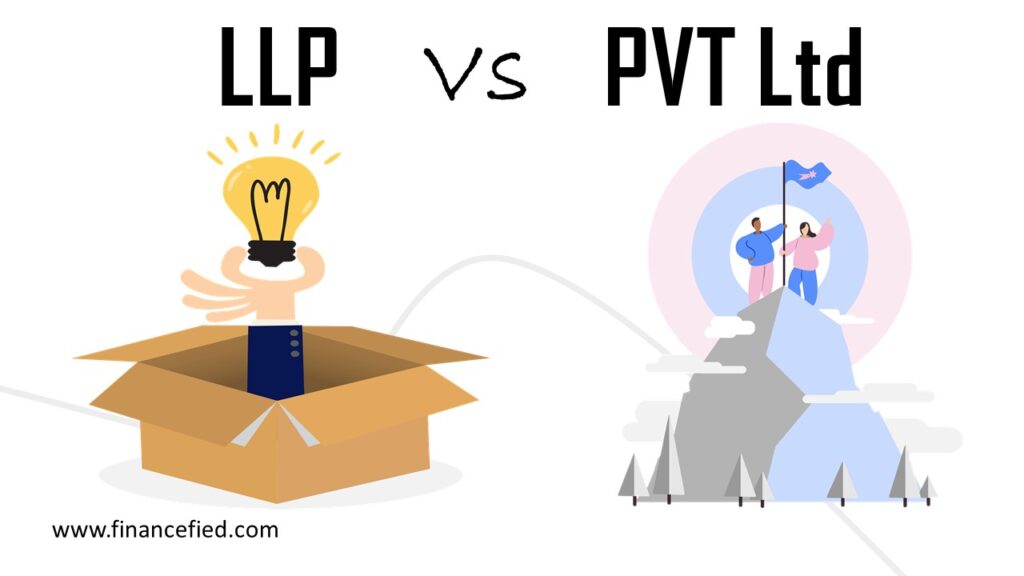LLP Vs PVT Ltd companies are popular forms of business organization. They differ in the following ways.

LLP Vs PVT Ltd
1. Owners:
Partners own LLP business. These partners manage their LLP. On the contrary, the owners of PVT Ltd are shareholders. Shareholders are not actual managers of a PVT Ltd business.
2. Maximum number owners:
LLP has no maximum limit of partners; they can be as many as existing partners wish. However, PVT Ltd is limited to only 200 shareholders as the maximum.
LLPs are recognized as corporate bodies. Partners enjoy the flexibility and limited liability, as would be the case of a company. This is not the case with PVT Ltd. Upon incorporation, PVT Ltd is recognized as a small business enterprise. To confine operations of this business within those of a small business enterprise, limiting the maximum number of owners to 200 is affected.
3. Shares transfer:
A partner can transfer their shares in LLP by executing an agreement with the existing partners. On the contrary, shareholders in a PVT Ltd could be limited on shares transfer in the article of association.
A PVT Ltd shareholder must abide by the shares transferability limitations stipulated in the article of association before signing a partnership agreement with others. If a shareholder feels like transferring their shares, they must do it within the provision of the article of association.
Transferring shares, in most cases, takes a lot of work. Much formal input goes into this process to recognize a new partner/shareholder as a successor of the rights and privileges of the exited partner.
4. Board meetings:
LLP is not obliged to hold formal meetings annually. On the other hand, PVT Ltd is obliged to hold at least four meetings annually.
Partners of an LLP can meet informally as prescribed in their partnership agreement. They can make decisions about different business operations in these informal meetings.
Since PVT Ltd are companies, board meetings must be held to decide on the routine matters of such businesses.
5. Raising Capital:
LLP can only raise capital from partners’ contributions or loans from financial institutions. On the contrary, PVT Ltd has more avenues for raising capital, like issuing new shares, taking loans, etc.
LLP is limited to capital from partners because to accept funds from a person; then they must be partners. An angel investor who does not wants to be a partner cannot fund an LLP business. If LLP wants to raise capital from venture capitalists, it must be incorporated as PVT Ltd and cease to exist as an LLP.
PVT Ltd is made up of shareholders but not partners. The shareholders can buy more shares in case of new issuance by the management. If the number of shareholders is below 200, new shareholders can buy new shares issued by such a company.
6. Management:
Partners of an LLP are both owners and managers of their business. However, the shareholders of PVT Ltd do not have managerial authority over their business.
This means a partner in an LLP business can make an active contribution regarding the management of business affairs. Therefore, there is no clear distinction between the owners of LLP and the management.
In the case of PVT Ltd, the management role is assigned to a board of directors. Owners (shareholders) do not have a direct contribution to the management of their company. This makes a clear distinction between the owners of PVT Ltd and its management.
7. Board of directors:
LLP does not have a board of directors. It is the role of partner managers to oversee its operations. On the contrary, PVT Ltd is managed by a board of directors. This board must have a minimum of two directors.
The board of directors acts on behalf of shareholders. It is there to protect the interest of shareholders and add more value to their capital contribution.
Related Articles:
- General Partner Vs Limited Partner: How Different are They?
- General Partnership Vs Limited Partnership Differences
- Dissolution of Partnership Firm: 6 Circumstances
- 20 Advantages and Disadvantages of Partnership
- Partnership Definition, Characteristics, Formation and Funding
- Characteristics of Corporation: 8 Most Common
- Corporation Advantages: 5 Most Important
- 4 Forms of Business Organization
- Limited Liability Company Definition, Formation and Types
- Sole Proprietorship Meaning and Examples
